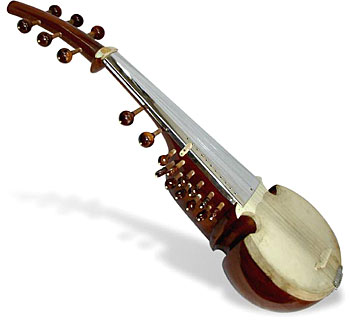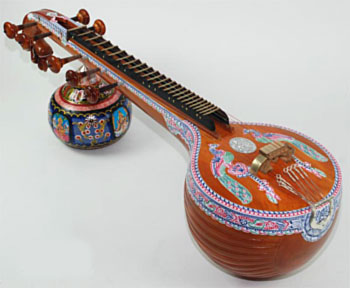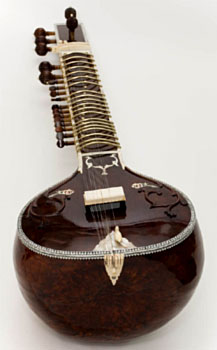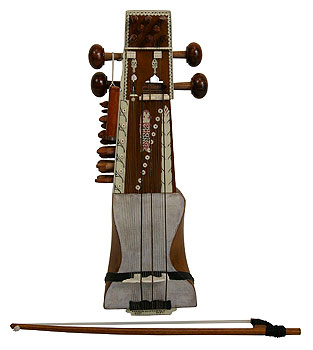 Performance in Indian music follows certain set movements. The musicians first acknowledge the audience usually with a traditional namaste, and then move on to checking and tuning their instruments. The ensemble in a given scenario varies according to the kind of music to be performed. As regards the seating arrangement of the entire ensemble, the soloist is at the centre-stage, and this can be either the soloist or the vocalist. The composition of the rest of the ensemble depends on the kind of music that is to be performed. However, certain features remain constant. A melody-producing soloist is joined by some drone-producing instruments and by one or more percussion instruments. Most of the times, there is also a second melody-producing instrument, which supports the soloist. In case of Hindustani vocal music, this translates into a sarangi for khayal and sarangi and harmonium for thumri. In the Hindustani instrumental ensembles, the shehnai group frequently includes a second melody- producing shehnai, which supports the soloist. Similarly, the vocal performances in Carnatic music include a supporting vocalist. In the case of Hindustani Dhrupad, where there is no accompanying melodic instrument, it is common for two singers to perform together and share the solo. This can happen with khayal and thumri as well. The solo-sharing role for melody making in the North is also found in frequent instrumental jugalbandi performances, such as sitar-sarod, shehnai-violin, sarod-violin, and sitar-surbahar (a large sitar). The performance practice remains the same: one line of melody at a time.
Performance in Indian music follows certain set movements. The musicians first acknowledge the audience usually with a traditional namaste, and then move on to checking and tuning their instruments. The ensemble in a given scenario varies according to the kind of music to be performed. As regards the seating arrangement of the entire ensemble, the soloist is at the centre-stage, and this can be either the soloist or the vocalist. The composition of the rest of the ensemble depends on the kind of music that is to be performed. However, certain features remain constant. A melody-producing soloist is joined by some drone-producing instruments and by one or more percussion instruments. Most of the times, there is also a second melody-producing instrument, which supports the soloist. In case of Hindustani vocal music, this translates into a sarangi for khayal and sarangi and harmonium for thumri. In the Hindustani instrumental ensembles, the shehnai group frequently includes a second melody- producing shehnai, which supports the soloist. Similarly, the vocal performances in Carnatic music include a supporting vocalist. In the case of Hindustani Dhrupad, where there is no accompanying melodic instrument, it is common for two singers to perform together and share the solo. This can happen with khayal and thumri as well. The solo-sharing role for melody making in the North is also found in frequent instrumental jugalbandi performances, such as sitar-sarod, shehnai-violin, sarod-violin, and sitar-surbahar (a large sitar). The performance practice remains the same: one line of melody at a time.
 In the south, ensembles are rather flexible where their choice of instruments for fulfilling traditional roles is concerned. However, their roles remain clear. A flute solo may be accompanied by the mridanga alone, or by the mridanga together with the ghatam or kanjira, or by one of the latter without the mridanga. For the purposes of melodic support, the flute may be joined by a violin or by another flute. The same type of flexibility is found also with veena, violin, and especially vocal-solo ensembles. The role of the supporting melodic instrument is one of partnership with the soloist.
In the south, ensembles are rather flexible where their choice of instruments for fulfilling traditional roles is concerned. However, their roles remain clear. A flute solo may be accompanied by the mridanga alone, or by the mridanga together with the ghatam or kanjira, or by one of the latter without the mridanga. For the purposes of melodic support, the flute may be joined by a violin or by another flute. The same type of flexibility is found also with veena, violin, and especially vocal-solo ensembles. The role of the supporting melodic instrument is one of partnership with the soloist.
In the case of North Indian ensembles however, the musical roles of the respective instruments differ with the performance genre. For instance, the drum is given different roles in vocal genres. In the case of Dhrupad, the pakhavaj player tries to match the rhythm of the song in a supportive partnership. In Khayal, the drummer functions as a timekeeper. He is supposed to repeat the theka of the particular tala again and again. This same role is also maintained in gayaki-style instrumental performances. In thumri, the drumming is less restricted in that the laggi section gives the drummer a chance to play in the spotlight. Only in the case of a solo Hindustani instrumental performance does he participate in a kind of partnership with the melody-producing soloist.
 In Hindustani ensembles, the role of accompanying stringed instrument is more constant. The role of the sarangi (and harmonium) is to shadow and thus support the melody of the soloist. The sarangi is used precisely because it is deemed most suitable for imitating the display of virtuosity, even the tonal quality, of a voice. Onstage, the tambura player just keeps plucking, keeping the drone steady. He too, will respond to a finely turned phrase. The accompanying stringed instruments join the soloist right from the beginning. When the drummer is not playing in the un-metered portions of a performance, he will also listen attentively; the soloist looks for his responses.
In Hindustani ensembles, the role of accompanying stringed instrument is more constant. The role of the sarangi (and harmonium) is to shadow and thus support the melody of the soloist. The sarangi is used precisely because it is deemed most suitable for imitating the display of virtuosity, even the tonal quality, of a voice. Onstage, the tambura player just keeps plucking, keeping the drone steady. He too, will respond to a finely turned phrase. The accompanying stringed instruments join the soloist right from the beginning. When the drummer is not playing in the un-metered portions of a performance, he will also listen attentively; the soloist looks for his responses.
The reactions of the audience comprise a major portion of a musical performance. Throughout a musical performance, be it Hindustani or Carnatic style, the audience is mostly musically educated. They listen closely and keep tala with their hands or in their head. The audience follows closely and reacts audibly and visibly when a fine phrase has been made. Reactions flow back and forth throughout a lengthy selection. The reactions of the audience are a must for the performer as it keeps the energy alive.
In Carnatic music, the inter-relationship between the different performers in the ensemble is more like a partnership. The ragam-tanam-pallavi sequence in Carnatic music is structured according to this principle of partnership. In ragam, a vocal soloist first sings alapana, and the violinist then follows suit. In pallavi, the portion referred to above, the tani (thani) avariam portion is entirely percussion, since the melody-producing soloist turns to keeping the tala. For the most part, however, the Carnatic performance partnership is not a partnership in the sense of equal responsibility. Mridanga players in an accompanying role used to cultivate a more independent style of cross-rhythmical counterpoint with the soloist than they do today. The former style is used more often now with the veena.
The main role of an accompanist is to have a good and immediate grasp of the soloist`s ideas and flawless repetition of the same. This does not imply that he merely echoes what the, but he has to lend support to what the soloist seeks to convey by connecting one idea to the next, by choosing a pitch register (unison or an octave above or below) that will emphasize or enhance tonal colour, by adjusting the playing style to reproduce the style of the solo melody, and so forth.
 The hierarchical structure of the performance ensemble, whether Hindustani or Carnatic, is defined by the degree of freedom in the music making, and by that definition the soloist reigns supreme. The kind of support given to the soloist fosters a kind of competition among the members of the performance ensemble and contributes to that partnership. Significant tension is created in the process, in attempting to produce someone else`s music, either a split second behind or after the phrase has ended, the contest between percussionists in tani avartam all contribute to lively and animated music making.
The hierarchical structure of the performance ensemble, whether Hindustani or Carnatic, is defined by the degree of freedom in the music making, and by that definition the soloist reigns supreme. The kind of support given to the soloist fosters a kind of competition among the members of the performance ensemble and contributes to that partnership. Significant tension is created in the process, in attempting to produce someone else`s music, either a split second behind or after the phrase has ended, the contest between percussionists in tani avartam all contribute to lively and animated music making.
In improvisatory performance, it is the responsibility of each artist to balance the various musical elements. A soloist must develop melody to the best of his creative ability and must be equally at home with rhythmic exploration. He must pace the improvisation so that it remains imaginative, and must go on to something else when the imagination runs out. An improvisatory performance is basically a musical `moment` that has never existed before and will never exist again in the same form. The shaping of a performance lies largely with the soloist and his is an enormous responsibility.
Thus, performance in Indian music involves a constant and complex interplay of elements. It is only when all the components are in order that the performance is complete.




















